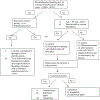Refractory anemia with ring sideroblasts (RARS) and RARS with thrombocytosis: "2019 Update on Diagnosis, Risk-stratification, and Management"
- PMID: 30618061
- PMCID: PMC6408294
- DOI: 10.1002/ajh.25397
Refractory anemia with ring sideroblasts (RARS) and RARS with thrombocytosis: "2019 Update on Diagnosis, Risk-stratification, and Management"
Abstract
Disease overview: Ring sideroblasts (RS) are erythroid precursors with abnormal perinuclear mitochondrial iron accumulation. Two myeloid neoplasms defined by the presence of RS, include refractory anemia with ring sideroblasts (RARS), now classified under myelodysplastic syndromes with RS (MDS-RS) and RARS with thrombocytosis (RARS-T); now called myelodysplastic/myeloproliferative neoplasm with RS and thrombocytosis (MDS/MPN-RS-T).
Diagnosis: MDS-RS is a lower-risk MDS, with single or multilineage dysplasia (SLD/MLD), <5% bone marrow (BM) blasts and ≥ 15% BM RS (≥5% in the presence of SF3B1 mutations). MDS/MPN-RS-T, now a formal entity in the MDS/MPN overlap syndromes, has diagnostic features of MDS-RS-SLD, along with a platelet count ≥450 × 10(9)/L and large atypical megakaryocytes.
Mutations and karyotype: Mutations in SF3B1 are seen in ≥80% of patients with MDS-RS-SLD and MDS/MPN-RS-T, and strongly correlate with the presence of BM RS; MDS/MPN-RS-T patients also demonstrate JAK2V617F, ASXL1, DNMT3A, SETBP1, and TET2 mutations. Cytogenetic abnormalities are uncommon in both.
Risk stratification: Most patients with MDS-RS-SLD are stratified into lower-risk groups by the revised-IPSS. Disease outcome in MDS/MPN-RS-T is better than that of MDS-RS-SLD, but worse than that of essential thrombocythemia. Both diseases have a low risk of leukemic transformation.
Treatment: Anemia and iron overload are complications seen in both and are managed similar to lower-risk MDS and MPN. The advent of luspatercept, a first-in-class erythroid maturation agent will tremendously boost the ability to manage anemia. Aspirin therapy is reasonable in MDS/MPN-RS-T, especially in the presence of JAK2V617F, but the value of platelet-lowering drugs remains uncertain.
© 2019 Wiley Periodicals, Inc.
Figures






Similar articles
-
Refractory anemia with ring sideroblasts (RARS) and RARS with thrombocytosis (RARS-T): 2017 update on diagnosis, risk-stratification, and management.Am J Hematol. 2017 Mar;92(3):297-310. doi: 10.1002/ajh.24637. Am J Hematol. 2017. PMID: 28188970 Free PMC article. Review.
-
Myelodysplastic syndromes with ring sideroblasts (MDS-RS) and MDS/myeloproliferative neoplasm with RS and thrombocytosis (MDS/MPN-RS-T) - "2021 update on diagnosis, risk-stratification, and management".Am J Hematol. 2021 Mar 1;96(3):379-394. doi: 10.1002/ajh.26090. Epub 2021 Jan 28. Am J Hematol. 2021. PMID: 33428785 Review.
-
Refractory anemia with ring sideroblasts and RARS with thrombocytosis.Am J Hematol. 2015 Jun;90(6):549-59. doi: 10.1002/ajh.24038. Am J Hematol. 2015. PMID: 25899435 Review.
-
Clinical Application for Diagnosis of Myelodysplatic/Myeloproliferative Neoplasm with Ring Sideroblasts and Thrombocytosis.Clin Lab. 2022 Apr 1;68(4). doi: 10.7754/Clin.Lab.2021.210738. Clin Lab. 2022. PMID: 35443589
-
Splicing factor mutations in MDS RARS and MDS/MPN-RS-T.Int J Hematol. 2017 Jun;105(6):720-731. doi: 10.1007/s12185-017-2242-0. Epub 2017 May 2. Int J Hematol. 2017. PMID: 28466384 Review.
Cited by
-
Bcor deficiency perturbs erythro-megakaryopoiesis and cooperates with Dnmt3a loss in acute erythroid leukemia onset in mice.Leukemia. 2021 Jul;35(7):1949-1963. doi: 10.1038/s41375-020-01075-3. Epub 2020 Nov 6. Leukemia. 2021. PMID: 33159179 Free PMC article.
-
Predicting survival in patients with myelodysplastic/myeloproliferative neoplasms with SF3B1 mutation and thrombocytosis.Leukemia. 2024 Jun;38(6):1334-1341. doi: 10.1038/s41375-024-02262-2. Epub 2024 May 7. Leukemia. 2024. PMID: 38714876 Free PMC article.
-
Genomics of myelodysplastic syndrome/myeloproliferative neoplasm overlap syndromes.Hematology Am Soc Hematol Educ Program. 2020 Dec 4;2020(1):450-459. doi: 10.1182/hematology.2020000130. Hematology Am Soc Hematol Educ Program. 2020. PMID: 33275756 Free PMC article. Review.
-
Hematopoietic Stem Cells (HSC) and Granulocyte Macrophage Progenitors (GMP) are the Oxidative Stress Targets in Low/Intermediate-1 Risk Myelodysplastic Syndromes.J Biotechnol Biomed. 2022;5(4):226-235. doi: 10.26502/jbb.2642-91280063. Epub 2022 Nov 9. J Biotechnol Biomed. 2022. PMID: 36644527 Free PMC article.
-
Myelodysplastic/myeloproliferative neoplasms with ring sideroblasts and thrombocytosis (MDS/MPN-RS-T): Mayo-Moffitt collaborative study of 158 patients.Blood Cancer J. 2022 Feb 1;12(2):26. doi: 10.1038/s41408-022-00622-8. Blood Cancer J. 2022. PMID: 35105856 Free PMC article.
References
-
- Swerdlow S, Camp E, Harris NL, Jaffe ES, Stefano PA, Stein H, Thiele J, Vardiman JW, ed WHO Classification of Tumors of Haematopoietic and Lymphoid Tissues. Lyon: International Agency for Research on Cancer; 2008.
-
- Arber DA, Orazi A, Hasserjian R, et al. The 2016 revision to the World Health Organization classification of myeloid neoplasms and acute leukemia. Blood. 2016;127(20):2391–2405. - PubMed
-
- Camaschella C Hereditary sideroblastic anemias: pathophysiology, diagnosis, and treatment. Semin Hematol. 2009;46(4):371–377. - PubMed
-
- Levi S, Corsi B, Bosisio M, et al. A human mitochondrial ferritin encoded by an intronless gene. J Biol Chem. 2001;276(27):24437–24440. - PubMed
Publication types
MeSH terms
Grants and funding
LinkOut - more resources
Full Text Sources
Research Materials
Miscellaneous
